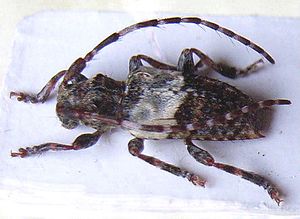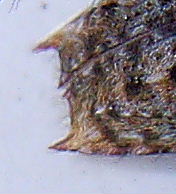Double-thorn batting
| Double-thorn batting | ||||||||||||
|---|---|---|---|---|---|---|---|---|---|---|---|---|

Double-thorned eyelash ( Pogonocherus hispidulus ) |
||||||||||||
| Systematics | ||||||||||||
|
||||||||||||
| Scientific name | ||||||||||||
| Pogonocherus hispidulus | ||||||||||||
| ( Linnaeus , 1758) |
The double Thorny eyelash Bock or tufts hinge bracket ( Pogonocherus hispidulus ) is a beetle of the family of longhorn beetles .
features
The beetles have three longitudinal ribs on the wing covers, on the back half of the longitudinal rib near the wing cover seam are small hairbrushes, hence the name batting. In P. hispidulus there are three dark tufts of hair.
The double-thorn batting is five to seven millimeters long. It is grained gray-black and has a broad, bright white transverse band on the front of the wing covers . The wing covers are drawn out to a small point at the back outside. With the double-thorn batting, the tips of the wing cover are not only drawn out into a pointed tooth, but also the inner angle at the wing cover seam is drawn out into a much smaller tooth. Hence the double-thorn in the name (picture).
The thorny batting ( Pogonocherus hispidus ) is very similar . However, it lacks the tooth on the wing cover seam. In addition, he only has two hairbrushes on the inner rib. But since the basal cusps of the elytra also carry a hairbrush, one also counts three tufts of hair on superficial examination. Other types of eyelashes may have one or no tooth at the end of the wing cover.
Occurrence
They occur on the bushy edges of mixed coniferous forests in southern , central and southern northern Europe , in the Mediterranean , in the Caucasus and in Transcaucasia . They are not uncommon.
Way of life
The larvae develop in various hardwoods and shrubs, also in conifers in dry branches and twigs. The development is usually two years and the hatched animals overwinter in the pupa cradle. The beetles appear from June to August.
Hazard and protection
- Saxony-Anhalt Red List (2004): 3 (endangered)
- Saxony Red List (1994): 3 (endangered)
Individual evidence
- ↑ , Jiři Zahradnik, Irmgard Jung, Dieter Jung et al .: Käfer Central and Northwestern Europe Parey Berlin 1985, ISBN 3-490-27118-1
- ↑ H. Freude, KW Harde, GA Lohse: Die Käfer Mitteleuropas. Volume 9, Spektrum Akademischer Verlag, 1966, ISBN 3-827-40683-8
- ^ Adolf Horion : Faunistics of the Central European Beetles, Vol. XII . Überlingen-Bodensee 1974.
- ↑ State Office for Environmental Protection Saxony-Anhalt (Ed.): Red list of longhorn beetles (Coleoptera: Cerambycidae) of the State of Saxony-Anhalt . in: Reports of the State Office for Environmental Protection Saxony-Anhalt 39 (2004) (2nd version, as of February 2004).
